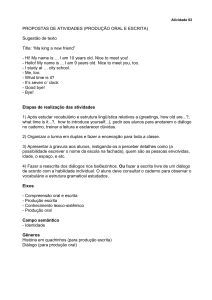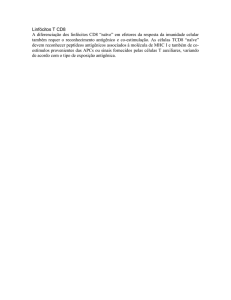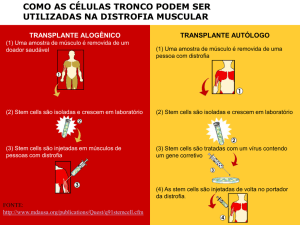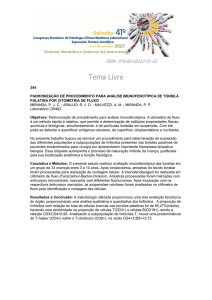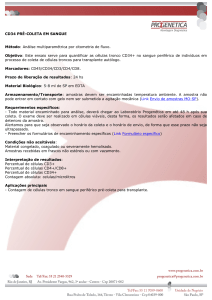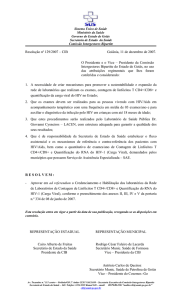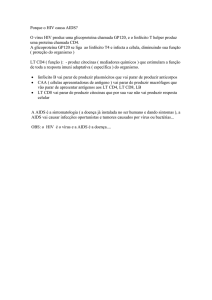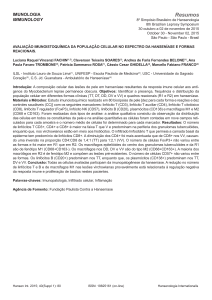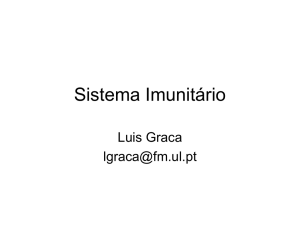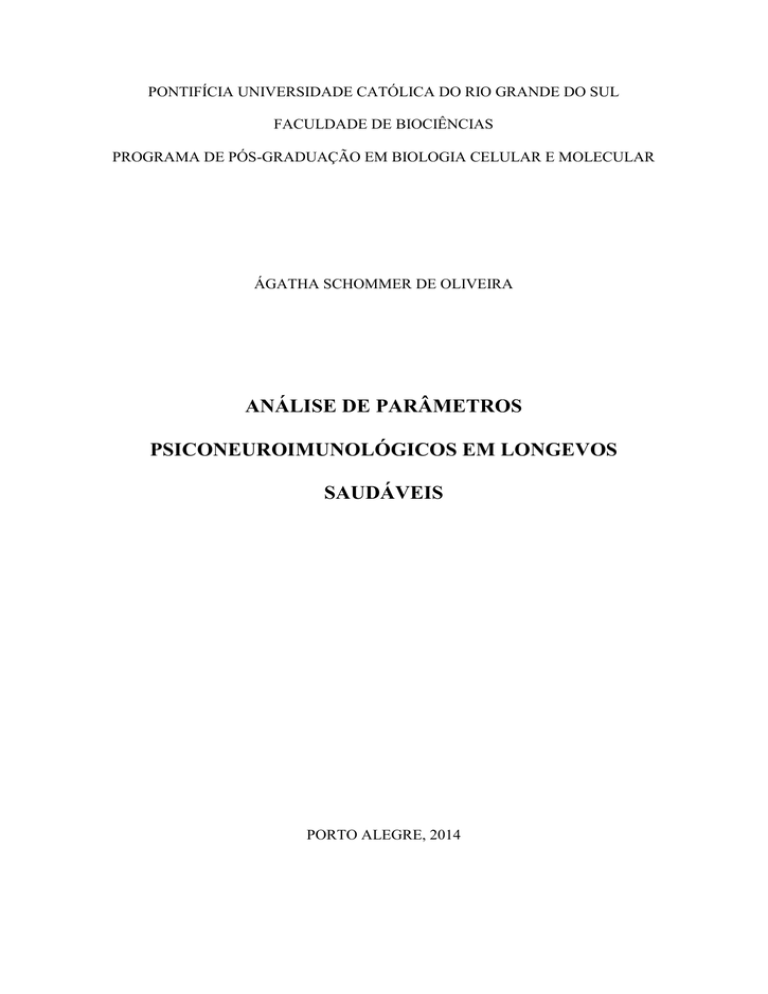
PONTIFÍCIA UNIVERSIDADE CATÓLICA DO RIO GRANDE DO SUL
FACULDADE DE BIOCIÊNCIAS
PROGRAMA DE PÓS-GRADUAÇÃO EM BIOLOGIA CELULAR E MOLECULAR
ÁGATHA SCHOMMER DE OLIVEIRA
ANÁLISE DE PARÂMETROS
PSICONEUROIMUNOLÓGICOS EM LONGEVOS
SAUDÁVEIS
PORTO ALEGRE, 2014
PONTIFÍCIA UNIVERSIDADE CATÓLICA DO RIO GRANDE DO SUL
FACULDADE DE BIOCIÊNCIAS
PROGRAMA DE PÓS-GRADUAÇÃO EM BIOLOGIA CELULAR E MOLECULAR
DISSERTAÇÃO DE MESTRADO
ANÁLISE DE PARÂMETROS
PSICONEUROIMUNOLÓGICOS EM LONGEVOS
SAUDÁVEIS
Dissertação de mestrado apresentada ao
Programa de Pós-Graduação em Biologia
Celular e Molecular da Pontifícia
Universidade Católica do Rio Grande do Sul
como requisito para obtenção do grau de
Mestre.
Autor
Ágatha Schommer de Oliveira
Orientador
Prof. Dr. Moisés Evandro Bauer
PORTO ALEGRE, 2014
Dedico esta dissertação aos meus pais,
pelo constante apoio, incentivo e compreensão.
AGRADECIMENTOS
Aos meus amigos que, de uma forma ou de outra, contribuíram com a sua amizade,
paciência e sugestões efetivas para a realização deste trabalho.
Aos meus pais, Karla e Ricardo, pelo total apoio e compreensão. Sem eles dificilmente
teria sido possível chegar até aqui. Obrigada por serem pais tão bons pra mim, é a vocês que
dedico esta dissertação.
Gostaria de agradecer ao professor Dr. Moisés Evandro Bauer por ter me orientado
sempre com muita competência e dedicação. Agradeço por todos os ensinamentos que foram
a mim transmitidos, pela confiança em mim depositada e por me permitir percorrer meus
próprios caminhos no decorrer dessa trajetória.
Ao professor Dr. Ângelo Bós e toda a equipe do Ambulatório Multiprofissional de
Atenção ao Longevo (AMPAL), por me receberem de braços abertos, sendo sempre muito
atenciosos, pacientes e prestativos. Com certeza o trabalho em equipe por nós realizado foi
fundamental para a conclusão deste trabalho.
Um agradecimento muito especial à minha colega e amiga Carine Hartmann, por estar
do meu lado desde o início, me ajudando em todos os experimentos, sempre com muita
paciência e dedicação. Obrigada por todo o incentivo e todas as sugestões. Foste essencial
para o desenvolvimento e conclusão deste trabalho e és responsável por grande parte da
bagagem de conhecimento que levo comigo deste mestrado. Agradeço também à colega e
amiga Dra. Andréa Wieck, por ser sempre tão paciente e prestativa, me ajudando,
principalmente com a escrita deste trabalho.
Aos demais colegas da pesquisa: Aline Zaparte, Laura Pettersen, Talita Baptista, Júlia
Motta, Natália Jaeger, Rafael Czepielewski e Júlia Molina. Muito obrigada pelo apoio,
carinho e paciência ao longo desses dois anos de mestrado.
iv
RESUMO
O envelhecimento bem sucedido é caracterizado pela habilidade do sistema imune em
manter algumas de suas funções intactas, evitando, assim, o aparecimento de doenças
relacionadas à idade, e, portanto, contribuindo para o alcance da longevidade. Além disso, o
envelhecimento bem sucedido também está relacionado a uma melhor maneira de lidar com o
estresse. Diversos estudos vêm demonstrando as alterações imunológicas ocorridas em
indivíduos idosos, assim como as consequências do estresse para o envelhecimento. No
entanto, poucos são os estudos que visam observar essas alterações em indivíduos longevos.
Neste estudo, analisamos fatores psíquicos e alterações nos subtipos linfocitários envolvidos
no envelhecimento e o papel destas alterações para o alcance da longevidade de maneira
saudável. Vinte longevos (86-99 anos), 15 idosos (60-80 anos) e 13 jovens adultos saudáveis
(20-50 anos) foram recrutados neste estudo. Os níveis de estresse foram avaliados pela Escala
de Estresse Percebido (PSS), enquanto que os níveis de depressão foram investigados através
do Inventário de Depressão Beck – II (BDI-II). As células mononucleares de sangue
periférico foram isoladas e os subtipos linfocitários avaliados por citometria de fluxo. Dentre
as populações avaliadas estão as células T CD4+, T CD8+, B CD19+ e células NK CD56+.
Observamos diversas alterações idade dependente nos subtipos linfocitários. Em particular,
foi evidenciada uma razão CD4/CD8 similar entre longevos e jovens, com um aumento desta
razão ocorrendo em indivíduos idosos. Um aumento significativo na percentagem das células
Natural Killers (CD56+CD16+) foi observado nos longevos, sugerindo que a atividade destas
células está bem preservada nestes indivíduos. Além disso, foi visto que os longevos são
menos estressados, quando comparados aos outros grupos. Concluindo, nossos resultados
sugerem que a combinação entre o aumento e o decréscimo de funções imunes específicas
pode gerar um balanço no sistema imune, contribuindo para que se alcance a longevidade de
forma saudável.
Palavras-chave: imunossenescência; linfócitos; envelhecimento saudável; citometria de
fluxo; estresse; depressão.
v
ABSTRACT
Healthy aging is characterized by the ability of the immune system in preserve some
of their functions intact, avoiding the appearance of some age-related diseases and thus
contributing to reaching longevity. Furthermore, healthy aging is associated to a better stress
coping. Studies have demonstrated immunological changes occurred in old individuals, as
well as the consequences of stress on aging. However, few studies have addressed such
changes in very old subjects. Here, we analyzed emotional factors and the changes in the
lymphocytes subpopulations involved on aging, and the role of these changes to reach
longevity healthily. A group of twenty healthy very old subjects together with a group of
healthy old individuals and a groups of healthy young adults were recruited in this study.
Stress levels were assessed by Perceived Stress Scale (PSS), while depression levels were
investigated by Beck Depression Inventories – II (BDI-II). Lymphocytes were isolated and
assessed by flow cytometry. We observed some age-related changes in lymphocyte
subpopulations. In particular, it was evidenced a similar CD4/CD8 ratio between very old
subjects and young adults, with this rate being increased in old subjects. A significant increase
in the percentage of Natural Killer cells (CD56+CD16+) was observed in the very old
subjects, showing that the activity of these cells is well preserved in this group of subjects.
Also, we noticed that very old subjects are less stressed, when compared to the other groups.
Our data suggests that the combination between increasing and decreasing specific immune
functions may generate a balance in the immune system, contributing to reach longevity
healthily.
Keywords: immunosenescence; lymphocytes, healthy aging; flow cytometry; stress;
depression.
vi
SUMÁRIO
1. CAPÍTULO 1 ................................................................................................................................................... 1
1.1.
INTRODUÇÃO ................................................................................................................................ 2
1.1.1.
IMUNOSSENESCÊNCIA ........................................................................................................................ 2
1.1.1.1. Alterações celulares na imunossenescência ............................................................................. 4
1.1.2.
Envelhecimento bem sucedido ......................................................................................................... 5
1.1.1.2. Alterações celulares no envelhecimento bem sucedido ............................................................ 6
1.1.3.
Fatores emocionais ............................................................................................................................ 7
1.2.
OBJETIVOS ..................................................................................................................................... 9
1.2.1.
Objetivo Geral ................................................................................................................................... 9
1.2.2.
Objetivos Específicos ........................................................................................................................ 9
2. CAPÍTULO 2 ................................................................................................................................................. 10
2.1.
ARTIGO CIENTÍFICO ................................................................................................................... 11
ABSTRACT ......................................................................................................................................................... 13
INTRODUCTION ............................................................................................................................................... 14
MATERIALS AND METHODS ....................................................................................................................... 15
SUBJECTS..... ...................................................................................................................................................... 15
BLOOD COLLECTION AND CELL ISOLATION ........................................................................................................... 16
IMMUNOPHENOTYPING ....................................................................................................................................... 16
ASSESSMENT OF STRESS LEVELS AND DEPRESSION ................................................................................................ 17
STATISTICAL ANALYSIS ......................................................................................................................................... 17
RESULTS....... ..................................................................................................................................................... 18
CHARACTERISTICS OF THE STUDIED POPULATIONS ............................................................................................... 18
LYMPHOCYTE SUBSETS ........................................................................................................................................ 18
DISCUSSION ...................................................................................................................................................... 19
REFERENCES .................................................................................................................................................... 23
3. CAPÍTULO 3 ................................................................................................................................................. 32
3.1.
CONSIDERAÇÕES FINAIS .......................................................................................................... 33
4. REFERÊNCIAS BIBLIOGRÁFICAS......................................................................................................... 37
vii
1. CAPÍTULO 1
1
1.1.
INTRODUÇÃO
1.1.1.
Imunossenescência
Quase todos os componentes do sistema imune sofrem reestruturações dramáticas
associadas com a idade. A imunossenescência é o resultado de um remodelamento
imunológico, onde algumas funções do sistema imune são reduzidas, outras permanecem
iguais e outras aumentam (Sansoni et al. 2008). De fato, o envelhecimento imunológico faz
parte de processos contínuos da ontogenia, abrangendo eventos complexos de
reorganização, mecanismos compensatórios e alterações qualitativas das funções imunes
(Haynes & Maue 2009). O declínio nas funções imunes acarreta aos indivíduos idosos
uma maior suscetibilidade a doenças infecciosas e tumores, levando a um aumento da
morbidez e mortalidade nesta população (Globerson & Effros 2000). Além disso,
paralelamente, o envelhecimento humano tem sido associado com mudanças psicológicas e
de comportamento, incluindo dificuldade na concentração, progressiva diminuição
cognitiva e distúrbios do sono (Bauer et al. 2009).
Diversas alterações relacionadas à imunossenescência podem ser observadas na
hematopoiese do indivíduo idoso. Dentre elas, o “pool” total de células-tronco sofre uma
diminuição na capacidade de auto-renovação, ocorre uma redução na geração de leucócitos
e uma diminuição no processo de linfopoiese (Peres Nardi, N. B., Chies, J. A. B. 2003).
Além disso, há o processo da involução tímica, principal alteração anatômico-histológica
observada no envelhecimento, que afeta diretamente a produção de células T e,
consequentemente, a capacidade de desenvolvimento de uma resposta imune eficiente
(Peres Nardi, N. B., Chies, J. A. B. 2003; Malaguarnera et al. 2001). Entretanto, sabe-se
2
hoje que com o aumento da idade o timo mantém a sua função normal, porém reduzida
(Globerson & Effros 2000).
O processo de envelhecimento parece afetar tanto a imunidade inata, representada
principalmente por monócitos, células natural killer (NK) e células dendríticas (DC),
quanto a imunidade adaptativa, representada pelos linfócitos T e B, mas de maneiras
diferentes: enquanto a imunidade inata parece ser melhor preservada, a imunidade
adaptativa manifesta profundas modificações idade-dependentes, como a redução no
número de linfócitos circulantes, o que é frequentemente prejudicial (Sansoni et al. 2008;
Franceschi & Bonafè 2003; Solana et al. 2006). O envelhecimento traz consigo uma
substituição de células T naive para células T de memória, níveis aumentados de células T
e B na medula espinhal e aumento na produção de citocinas (Globerson & Effros 2000;
Miyaji et al. 2000). A geração e manutenção de linfócitos de memória é um evento crucial
na resposta imune, de fato, dada a característica de facilitarem uma resposta a antígenos
previamente encontrados, essas células são essenciais para uma vacinação efetiva (Buffa et
al. 2011).
Estudos recentes sugerem que uma infecção a longo prazo pelo Citomegalovirus
(CMV), vírus β-herpes humano, acelera as alterações relacionadas a idade na composição
do repertório de células T. As células T CD8+ são mais afetadas pelo CMV do que as
células CD4+. A infecção latente ao CMV é tipicamente acompanhada por um decréscimo
nas células T naive e no simultâneo acumulo de células T efetoras (Weinberger et al. 2007;
Pawelec et al. 2005). Além disso, o CMV está relacionado com um aumento do Perfil de
Risco Imune (IRP), mudanças da capacidade imune associadas à idade que resultam em
um aumento da morbidez e mortalidade, juntamente com uma baixa razão CD4/CD8 e com
um aumento das células T CD28- (Weinberger et al. 2007; Strindhall et al. 2007).
3
1.1.1.1.
Alterações celulares na imunossenescência
Diversas mudanças relacionadas aos subtipos linfocitários são observadas no
sistema imunológico de indivíduos idosos. As células T CD4+ possuem inúmeras funções,
incluindo a ativação de células do sistema imune inato, linfócitos B, citotoxidade de
células T além de possuírem um papel essencial na supressão da reação imune (MoroGarcía et al. 2013). Já as células T CD8 são ditas células tanto com potencial regulatório
como com potencial citotóxico, sendo essenciais para o reconhecimento e remoção de
células infectadas por patógenos intracelulares além de serem peças-chave na resposta
imune antitumoral (Fagnoni et al. 1996; Strioga et al. 2011). Estudos prévios observaram
uma diminuição de capacidade funcional, integridade celular, e diversidade tanto em
células T CD4+ quanto em células T CD8+ durante o envelhecimento (Alam et al. 2012).
Além disso, foi demonstrado que durante o envelhecimento há um decréscimo no número
de moléculas CD28, necessárias para iniciar uma resposta imune mediada por células T,
nos linfócitos circulantes, principalmente entre as células T CD8+ (Fagnoni et al. 1996; do
Prado et al. 2012; Sansoni et al. 1997).
Também são vistas alterações idade-dependente nos linfócitos B, necessários para a
produção de anticorpos (Buffa et al. 2011). Estudos relatam uma redução no número de
linfócitos B em indivíduos idosos, o que pode estar correlacionado com um estado de
saúde piorado nesses sujeitos (Colonna-Romano et al. 2008; Buffa et al. 2011). Já a
atividade das células NK, que possuem atividade citotóxica e são essenciais para a
iniciação da resposta imune adaptativa, é bem preservada durante toda a vida, desde jovens
até centenários, porém, foi visto uma diminuição na atividade das células NK em pessoas
de meia idade (Sansoni et al. 1993; Chen & Liao 2007).
4
1.1.2. Envelhecimento bem sucedido
A longevidade é alcançada quando o envelhecimento é uniforme, quando todos os
órgãos e aparelhos são afetados pelo mesmo prejuízo funcional, evitando que o colapso de
uma única função possa envolver todo o organismo (Tafaro et al. 2009). O envelhecimento
bem sucedido envolve uma melhor tolerância ao estresse através de eficientes estratégias
de ajuste cognitivo, baixo nível de estresse ambiental, menor reatividade ao estresse e
suporte social de melhor qualidade (Pardon 2007, Weinert & Timiras 2003). Além disso, a
autoestima é conhecida por influenciar a ocorrência de sintomas de depressão relacionados
ao estresse (Pardon 2007).
Dentre as diferentes estratégias utilizadas para lidar com o estresse, estudos relatam
que exercícios adequados ajudam a relaxar a e eliminar doenças fisiológicas e psíquicas
relacionadas ao mesmo (Chen & Liao 2007). Atletas, por exemplo, possuem uma função
imune mais forte, incluindo a citotoxidade das células NK, além de uma baixa prevalência
e mortalidade por cânceres (Nieman et al. 1993). Outro importante fator relacionado a
obtenção da longevidade de forma saudável é uma boa alimentação. O consumo de
micronutrientes, como vitaminas, minerais essenciais e outros componentes necessários em
pequenas porções para um metabolismo normal contribuem para um estado de saúde
melhor e, consequentemente, resultando em uma alta probabilidade de escapar de várias
doenças relacionadas ao envelhecimento (Chen & Liao 2007).
Os centenários são ótimos exemplos do envelhecimento bem sucedido. Estudos
prévios mostram que eles apresentam diversas funções da imunidade inata ou adaptativa
intactas, e que, na ausência de qualquer doença notória, é possível atingir níveis extremos
do tempo de vida humano com uma saúde relativamente boa (Bauer et al. 2009; Franceschi
& Bonafè 2003). Além disso, centenários normalmente possuem uma personalidade
5
peculiar e um humor positivo que possivelmente os ajuda a encarar os estresses da vida e
contribuem para a sua sobrevivência (Franceschi et al. 2007).
1.1.1.2.
Alterações celulares no envelhecimento bem sucedido
Atualmente, existem poucos estudos analisando quais fatores estão envolvidos no
envelhecimento saudável, e, principalmente, quase nenhum estudo comparando populações
de jovens, idosos e longevos. Estudos demonstraram que a atividade das células NK é
importante na manutenção da saúde durante o envelhecimento e é um pré-requisito para a
longevidade (Chen & Liao 2007; Solana et al. 2006). A citotoxidade bem preservada das
células NK é observada em indivíduos idosos saudáveis e em centenários, em particular
naqueles com independência em realizar as atividades diárias, funções cognitivas
adequadas ou aptidão física. A alta citotoxidade das células NK está relacionada com um
estado de saúde melhor e baixa incidência de infecções do trato respiratório em indivíduos
idosos, assim como um melhor desenvolvimento de títulos protetivos de anticorpos em
resposta a vacina da gripe (Solana et al. 2006).
Outro fator importante associado à longevidade é a manutenção das funções das
células T CD8+ e a remoção de células T experientes não funcionais (Hsu et al. 2006).
O número constante de células T CD4+ e T CD8+ no sangue periférico de idosos,
incluindo centenários, pode ser devido à proliferação homeostática das células T,
envolvendo, inclusive, células de memória. Dessa forma, existe a hipótese de que esta
reformulação da população de células T tem como consequência um aumento do número
de células T citotóxicas e de células produtoras de citocinas, o que pode criar um ambiente
hostil para o crescimento de células cancerígenas (Franceschi & Bonafè 2003).
Franceschi et al. (2003) afirmam que o fato de pessoas com mais de 85 anos
possuírem uma menor probabilidade de desenvolver um câncer pode ser explicada, em
6
parte, pelo fato de a imunossenescência estar associada com uma expansão progressiva de
células T CD28-, as quais possuem características intermediárias entre células T e células
NK, porém, os estudos ainda são controversos. Além disso, a ausência de expressão de
CD28 indica que a célula já passou por diversas divisões celulares e se encontra em estágio
de diferenciação terminal.
1.1.3. Fatores psíquicos
Fatores psíquicos tais como o estresse, a depressão e a ansiedade contribuem para
um envelhecimento precoce. A velocidade do relógio biológico depende da interação entre
herança genética e o ambiente. Uma má interação pode levar a morte prematura, enquanto
uma excelente interação poderá levar a uma morte natural após os 100 anos (Tafaro et al.
2009).
O estresse é dito como um dos principais aceleradores do relógio biológico (Hsu
et al. 2006). A reação a um estressor pode ser considerada positiva ou negativa, levando
em conta a qualidade de sensações sentidas pelo indivíduo e o impacto no organismo
(Tafaro et al. 2009). Indivíduos idosos com estresse crônico sofrem o risco de desenvolver
patologias relacionadas ao estresse, tais como depressão e ansiedade, além de possuir
funções imunes mais fracas (Bauer et al. 2009; Tafaro et al. 2009). Altos níveis de estresse
e ansiedade estão, além de tudo, relacionados com uma baixa performance cognitiva
(Bunce et al. 2012).
Estereótipos sugerem que pessoas que se tornam rígidas, nervosas, introvertidas e
frustradas com o avanço da idade possuem um maior risco de desenvolver depressão
(Tafaro et al. 2009). Além disso, foi observado que o estresse psicológico está
significativamente associado com um estresse oxidativo mais alto, baixa sensibilidade a
glicocorticoides, aumento nos níveis de cortisol, atividade da telomerase mais baixa e
7
comprimento menor de telômeros, que, como se sabe, são determinantes da senescência da
célula e longevidade (Bauer 2008). Um encurtamento telomérico acelerado é um sinal de
envelhecimento celular em pessoas com estresse crônico e em depressão e pode estar, pelo
menos em parte, relacionado ao aumento da produção de cortisol relacionado ao estresse e
catecolaminas. Dados sugerem que um aceleramento do encurtamento telomérico depende
da duração do tempo de exposição a depressão (Wolkowitz et al. 2010).
As células T são especialmente afetadas durante a exposição ao estresse crônico.
Estudos mostram que a quantidade células T regulatórias, responsáveis por “desligar” as
respostas imunes contra antígenos próprios em doenças auto imunes, alergia ou micróbios
comensais em certas doenças inflamatórias, podem aumentar com a exposição ao estresse
crônico (Höglund et al. 2006; Bauer 2008). Além disso, foi visto que indivíduos expostos a
estresse crônico possuem uma diminuição na quantidade de células T naive e células B,
uma baixa proliferação das células T e uma menor atividade das células NK, o que faz com
que haja um aumento da morbidez, com, por exemplo, o aparecimento de infecções,
hipertensão, doença cardiovascular e uma piora na cicatrização de feridas, e um aumento
na mortalidade (Bauer 2008). No entanto, nenhum estudo até o momento investigou o
papel dos fatores emocionais na resposta imune durante o envelhecimento bem sucedido.
8
1.2.
OBJETIVOS
1.2.1. Objetivo Geral
Analisar aspectos psiconeuroimunológicos em longevos saudáveis.
1.2.2.
Objetivos Específicos
Recrutar grupos de jovens adultos, idosos e longevos;
Avaliar os principais subtipos linfocitários;
Avaliar fatores psíquicos relacionados ao estresse e à depressão;
Relacionar fatores psíquicos com subtipos celulares.
9
2. CAPÍTULO 2
10
2.1.
ARTIGO CIENTÍFICO
11
À ser submetido ao Biogerontology
REMODELING OF IMMUNOSENESCENCE IS NOT
ASSOCIATED WITH PSYCHOSOCIAL DISTRESS IN THE
VERY OLD
1
Ágatha Schommer de Oliveira, 1Carine Hartmann do Prado, 1Andréa Wieck,
2
1
Ângelo Bos and 3Moisés Evandro Bauer
Laboratory of Immunosenescence, Institute of Biomedical Research, Pontifical Catholic
University of the Rio Grande do Sul (PUCRS), Porto Alegre, Brazil;
2
Institute of Geriatrics and Gerontology, PUCRS, Porto Alegre, Brazil.
3
Faculty of Biosciences, PUCRS, Porto Alegre, Brazil;
Correspondent author: Moisés E. Bauer, PhD, Instituto de Pesquisas Biomédicas, Hospital
São Lucas da PUCRS, Av. Ipiranga 6690, 2º andar. P.O. Box 1429. Porto Alegre, RS 90.610000, Brazil. Email: [email protected]
12
ABSTRACT
Background: During aging the immune system remodels, a process known as
immunosenescence, and circulating lymphocytes have been associated with extreme
longevity. Although psychosocial stress was associated with premature aging of the immune
system, the role of stress factors on successful aging is largely unknown. Objective: To
investigate the psychosocial and immunological correlates of very old subjects. Methods:
Healthy community-dwelling young adults (20-50 years), old (60-80 years) and very old
subjects (86-99 years) took part in this study. Perceived stress and depression scores were
assessed by structured questionnaires. Lymphocytes were isolated and immunophenotyped by
flow cytometry to investigate the following subsets: helper T cells, cytotoxic T cells, activated
and late-differentiated T cells, B cells, natural killer (NK) cells, and NKT cells. Results: All
groups were homogenous regarding both stress and depression scores. Very old subjects had
reduced percentages of helper T cells (CD3+CD4+) compared with the other groups. There
was a significant expansion of NK cells (CD56+CD16+) in the very old group. While
activated T cells decreased, the senescence-associated T cells (CD8+CD28- and CD4+CD28-)
were found significantly increased in very old subjects. Conclusions: our data further
suggests the immune system remodels during aging and it was not associated with
psychosocial distress in the extreme longevity.
Keywords: immunosenescence, lymphocytes, psychosocial stress, extreme longevity.
13
Introduction
The aging immune system (immunosenescence) involves a continuing reorganization
during life that either progressively drives the appearance of age-related diseases or is
associated with extreme longevity (Colonna-Romano et al. 2008). The immunosenescence is
accompanied by changes in both innate and adaptive immunity (Sansoni et al. 2008), while
the innate immunity seems to be better preserved at the expense of highly modified adaptive
changes, which are often detrimental (Solana et al. 2006; Sansoni et al. 2008). As a
consequence, the elderly subjects show reduced immunity to new infections and decreased
responses to vaccines (Buffa et al. 2011). Longevity can be represented by a well-functioning
immune system which allows the prevention of the main age-related pathologies, such as
infections and cancer (Sansoni et al. 2008).
Several remodeling changes of the adaptive immune system can be described during
aging. Of note, it has been observed a loss of expression of the activation marker CD28+, a
major co-stimulatory receptor, on both CD8+ and CD4+ T cells during aging (Hsu et al.
2006) in parallel with a progressive expansion of late differentiated or senescence-associated
CD28- T cells (Fagnoni et al. 1996; Czesnikiewicz-Guzik et al. 2008). Besides, a low
CD4/CD8 ratio has been observed in aging and associated with increased mortality in very
old subjects (Provinciali et al. 2009). Furthermore, several studies report age-related
expansions of natural killer (NK) cells (CD56+CD16+); which can be considered a biomarker
of healthy aging and longevity (Solana et al. 2006; Almeida-Oliveira et al. 2011). In addition,
the B cell compartment is also modified during aging. A previous study showed a reduced
number of B lymphocytes (CD3-CD19+) in old and very old subjects (Colonna-Romano et al.
2008). However, little is known about the immune profile and associated lifestyle
characteristics of successful aging and extreme longevity.
14
Increased psychosocial stress and correspondent stress hormones have been associated
with premature aging of the immune system (Bauer et al. 2009). While aging is characterized
by the declining ability to cope with stress, which contributes to longevity (Weinert and
Timiras 2003), emotional factors, such as stress, depression and anxiety are known to
contribute to premature aging (Tafaro et al. 2009). The speed of individuals biological clock
depends on the important interaction between genetic inheritance and environment (Tafaro et
al. 2009), and stress has been considered one of the major contributors for racing the
biological clock (Esch 2003). Previous studies from our group found that healthy aging
(SENIEUR) was associated with significant age-related distress and increased cortisol levels
implicated with premature immunosenescence (Bauer 2008). In addition, chronically stressed
elderly individuals exhibit poorer immune functions, increased morbidity, and are primed to
display exaggerated inflammatory responses (Gouin et al. 2008; Bauer et al. 2009).
Furthermore, it has been observed that psychological stress was significantly associated with
higher oxidative stress, lower telomerase activity, short telomere lengths, thymic involution
and chronic low-grade inflammation, which are all known determinants of cell senescence
and longevity (Bauer 2008; Bauer et al. 2009). However, the psychosocial stress determinants
of successful aging (extreme longevity) are largely unknown.
Here, we investigated a comprehensive panel of lymphocyte subpopulations as well as
the perceived stress and depression scores in healthy very old, old, and young adults.
Materials and methods
Subjects
Forty-eight healthy individuals were recruited at the Gerontology and Geriatrics
Institute (São Lucas Hospital, Porto Alegre, Brazil) and subgrouped into very old (86–99
15
years; n=20), old (60-80 years; n=15) and young adults (20–50 years; n=13). All subjects
provided their written informed consent before inclusion in the study, which was approved by
the Ethical Committee of the institution. Exclusion criteria included: a) acute infections (last
month); b) presence or history of neoplasias; c) neurodegenerative diseases; and d) mood
disorders.
Blood collection and cell isolation
Twenty milliliters of peripheral blood were collected by venipuncture and stored in
EDTA tubes prior to analyses. Peripheral blood mononuclear cells (PBMCs) were isolated by
density gradient under centrifugation for 30 min at 900 g. Cells were counted by means of
microscopy (100 x) and viability always exceeded 95%, as judged from their ability to
exclude Trypan Blue (Sigma). PBMCs were resuspended complete culture medium (RPMI1640, supplemented with 0.5% gentamicine, 1% glutamine, 1% hepes, 0.1% fungizone, and
10% fetal calf serum, FCS; all from Sigma) and adjusted to yield a final concentration of
2x105 cells/well.
Immunophenotyping
A large panel of lymphocyte subsets was identified by multi-color flow cytometry.
Briefly, PBMCs were washed in flow cytometry buffer (PBS containing 1% FCS and 0.01%
sodium azide) and treated with Fc Block solution for 20 min. In order to evaluate specific
lymphocyte subsets, cells were stained for 30 min with combinations of the following
monoclonal antibodies: anti-CD3 FITC, anti-CD3PECy5, anti-CD4 PE, anti-CD8 PE, antiCD8PECy5, anti-CD19 PE, anti-CD56 FITC, anti-CD28 FITC, anti-CD69 FITC, antiCD16PECy7 (all from BD Biosciences, San José, CA, USA). Immediately after staining, cells
were washed, resuspended and analyzed by flow cytometry. A minimum of 20,000
16
lymphocytes were identified by size (FSC) and granularity (SSC) and acquired with a FACS
Canto II flow cytometer (BD Biosciences). The instrument has been checked for sensitivity
and overall acquisition. Data were analyzed using the Flowjo 7.2.5 software (Tree Star Inc.,
Ashland, Or, USA).
Assessment of stress levels and depression
Stress levels were assessed by the Perceived Stress Scale (PSS). This scale measures
the degree to which individuals perceive situations as stressful during the last month. The
depression levels were investigated by Beck Depression Inventories – II (BDI-II). The clinical
interpretation includes the following range: 0-13: minimal depression; 14-19: mild
depression; 20-28: moderate depression; and 29-63: severe depression. Psychosocial stress
and depression were evaluated by a trained psychologist who was blinded to the subject.
Statistical analysis
All variables were tested for homogeneity of variances and normality of distribution
by means of the Levene and Kolmogorov-Smirnov tests, respectively. Differences between
groups were analyzed using one-way ANOVA. Statistical interactions between categorical
variables were compared by means of the chi-square (2) test. Statistical analyses were
performed using the Statistical Package for Social Sciences, SPSS Statistics 17.0 software
(SPSS Inc., Chicago, IL, USA). The significance level was set at = 0.05 (two-tailed).
17
Results
Characteristics of the studied populations
Demographic and clinical characteristics of the samples are summarized in Table 1.
Both groups were homogenous regarding BMI, ethnicity, smoking and drinking habits. Both
perceived stress during the last month and depression (BDI) scores did not vary between
groups. Also, we found no correlation between immunological and psychological variables.
Lymphocyte subsets
We screened a large panel of circulating lymphocyte subsets by flow cytometry,
including activation, regulatory and immunosenescence phenotypes (Table 2). We found
significant difference on T helper cells (CD3+CD4+) between groups (F=11.9, p<0.01; Figure
1A); a decreased age-related percentage of these cells was observed. The CD4/CD8 ratio was
found significantly increased in the old group (F=7.22, p<0.05) when compared to the young
adults and the very old groups (Figure 1B), but no significant alterations could be observed
between young adults and very old group.
The percentage of activated T cells (CD8+CD28+ and CD4+CD28+) were found
decreased in the very old group (Figure 2A; Figure 2B, respectively). The percentage of
CD8+CD28+ T cells was significantly increased in the young adults group comparing to the
old and the very old groups (F=2.45, p<0.01; Figure 2A). Also, the percentage of
CD4+CD28+ T cells differed significantly between the three groups, being increased in the
young adults group, but gradually decreasing in the old and very old groups (F=45.34,
p<0.01; Figure 2B). Late differentiated or senescent T cell subpopulations (CD8+CD28- and
CD4+CD28-) were also found significantly altered in the very old group. While no alterations
could be observed between the old and the young adults, the very old had an expansion of
18
CD8+CD28- cells compared to both old and young adults group (F=9.99, p<0.01; Figure 2C).
Yet, CD4+CD28- cells differed significantly only between the young adults and the very old
groups (F=1.27, p<0.01; Figure 2D), with no differences regarding old and very old groups.
The percentage of NK cells (CD56+CD16+) was significantly increased in the very old group
when compared to the old group (F=4.58, p<0.05; Figure 3A).
Discussion
To the best of our knowledge, this is the first study describing the psychosocial status
and its potential implications for the immune system in the very old subjects.
We reported no significant difference in stress and depression scores between the
studied groups. Our findings are in agreement with previous studies in the literature which
indicates that depression may be a characteristic of neuropathological aging, together with
aspects related to old age, such as being frail or being alone during part of the day (van’t
Veer-Tazelaar et al. 2008; Bunce et al. 2012). Also, there is a positive relationship between
depression and poorer cognitive functions in old age (Bunce et al. 2012). In contrast, very old
subjects seem to be less stressed than the other groups. Studies addressing stress in elderly
subjects are very controversial. Our data corroborates the hypotheses that healthy aging is
associated to a positive and efficacious coping with stress and that less stressed subjects are
able to age healthily (Tafaro et al. 2009). This should be further explored in future studies as
well as other characteristics involved in buffering stress responses, including lifestyles and
temperament. In contrast, other studies indicates that healthy aging is associated with
significant psychological distress, with elderly being more stressed, anxious and depressed
than young adults (Bauer 2008). Indeed, more studies are required to analyze which factors
might promote better coping with stress exposure (or resilience) in the extreme longevity.
19
Here, we investigated a large panel of lymphocyte subsets, including activated and
regulatory cells, which may have important role in the immunosenescence. Of special note,
specific remodeling changes in circulating lymphocytes were observed when the groups were
compared. There was an age-related drop in the percentage of helper T cells (CD3+CD4+).
Circulating CD4+ T cells act mostly as T-helper cells, by triggering signals to B-cell
activation for antibody production (Müller and Pawelec 2013). Low percentages of T helper
cells are linked to decreased responsiveness to infections and impaired generation of
protective immunity to vaccines, a common characteristic of the immune system from old
individuals (Boraschi et al. 2013). The CD4/CD8 ratio was found increased in the old subjects
compared to young adults and very old. Previous longitudinal studies have defined an elderly
group (octa- and nonagenarians) with inverted CD4/CD8 ratio, poor T cell proliferation and
increased cytomegalovirus (CMV) serology, associated with increased 2-year mortality
(Nilsson et al. 2003; Provinciali et al. 2009). This group was defined as Immune Risk
Phenotype (IRP) and in our study only three very old subjects could be identified with
inverted CD4/CD8 ratio. Studies suggests that alterations in this T cell compartment during
aging can be due to thymic involution, antigen exposition, clonal expansion, homeostatic
proliferation, and regulatory interactions (Peres Nardi, N. B., Chies, J. A. B. 2003; Sansoni et
al. 2008). Certain conditions have been shown to specifically alter CD4/CD8 ratio. Human
CMV is a persistent β-herpes infection with profound effects on the CD8 subset, resulting in
expansion of CD8+ cells and a compensatory decrease in the CD4 subset(Wikby et al. 1998).
The CMV has increased age-related prevalence, ranging from 40% (18-24 years old) to over
90% (75-80 years old) (Badami et al. 2009). Here, no changes were observed in total
CD3+CD8+ cells in very old subjects, indicating that some of the lymphocytes may return to
similar counts to those of young adults.
20
Another characteristic of adaptive immunosenescence is an age-related loss of CD28
molecule. The CD28 is a co-stimulatory molecule necessary to initiate T cell mediated
immune responses (do Prado et al. 2012). It has been involved with several processes of cell
senescence, including shortened telomeres, limited proliferative potential and resistance to
apoptosis (Valenzuela and Effros 2002; Hsu et al. 2006). Also, T cells that lose the expression
of CD28 may exhibit reduced vaccine responsiveness (Hsu et al. 2006). In accordance with
previous works (Fagnoni et al. 2000; Alam et al. 2013), we reported an age-related loss of
expression of CD28+ in both CD4+ and CD8+ T cells, with stronger effect on CD8+ T cells.
The CD8+CD28- T cells have regulatory functions, are defined as highly expanded,
terminally differentiated or senescent memory T cells (do Prado et al. 2012). In addition, the
expansion of CD4+CD28- cells are considered with high pro-inflammatory and tissuedamaging potential, being related with various immune disorders, including auto immune
diseases, chronic inflammatory diseases, immune deficiency, and chronic persistent infections
(Warrington et al. 2003; Broux et al. 2012). Regarding the latter, the CMV has been shown to
expand CD8+CD28- T cells in elderly populations (Looney et al. 1999).
NK cells are traditionally defined as cellular mediators of innate immunity, and are
defined by their ability to kill cancer cells and virally infected cells without prior sensitization
(Almeida-Oliveira et al. 2011; Vallejo et al. 2011). Besides, they are essential for the
stabilization and protection of chromosomal end and for the regulation of cell replicative
capacity (Mariani et al. 2003). In accordance to previous works, NK cells (CD56+CD16+)
were found significantly increased in the very old group compared to the old group (Miyaji et
al. 2000; Almeida-Oliveira et al. 2011). The ability of NK cells to exert cytotoxic function
seems to be well preserved until old age, and high NK activity was found as a prerequisite for
good health and longevity (Castle 2000; Chen and Liao 2007). Conversely, low NK activity
was found to be a good predictor of morbidity (Levy et al. 1991; Chen and Liao 2007).
21
In conclusion, our data give further support to the knowledge that immune system
remodels during aging. This cellular remodeling is not apparently regulated by the
psychosocial distress in the extreme longevity, further indicating that better coping strategies
or resilience have been developed by very old individuals.
Acknowledgments
We are very grateful to the subjects and staff at the São Lucas Hospital (Porto Alegre,
Brazil). This work was supported by grants from CNPq and CAPES.
22
References
Alam I, Goldeck D, Larbi A, Pawelec G (2013) Aging affects the proportions of T and B cells
in a group of elderly men in a developing country—a pilot study from Pakistan. Age
(Omaha) 35:1521–1530.
Almeida-Oliveira A, Smith-Carvalho M, Porto LC, et al. (2011) Age-related changes in
natural killer cell receptors from childhood through old age. Hum Immunol 72:319–329.
Badami KG, McQuilkan-Bickerstaffe S, Wells JE, Parata M (2009) Cytomegalovirus
seroprevalence and “cytomegalovirus-safe” seropositive blood donors. Epidemiol Infect
137:1776–1780.
Bauer ME (2008) Chronic stress and immunosenescence: a review. Neuroimmunomodulation
15:241–250.
Bauer ME, Jeckel CMM, Luz C (2009) The role of stress factors during aging of the immune
system. Ann N Y Acad Sci 1153:139–152.
Boraschi D, Aguado MT, Dutel C, et al. (2013) The gracefully aging immune system. Sci
Transl Med 5:185–188.
Broux B, Markovic-Plese S, Stinissen P, Hellings N (2012) Pathogenic features of
CD4+CD28– T cells in immune disorders. Trends Mol Med 18:446–453.
Buffa S, Bulati M, Pellicanò M, et al. (2011) B cell immunosenescence: different features of
naive and memory B cells in elderly. Biogerontology 12:473–483.
Bunce D, Batterham PJ, Mackinnon AJ, Christensen H (2012) Depression, anxiety and
cognition in community-dwelling adults aged 70 years and over. J Psychiatr Res
46:1662–1666.
Castle SC (2000) Clinical relevance of age-related immune dysfunction. Clin Infect Dis
31:578–585.
Chen Y, Liao H (2007) NK/NKT cells and aging. Int J Gerontol 1:65–76.
Colonna-Romano G, Bulati M, Aquino A, et al. (2008) B cell immunosenescence in the
elderly and in centenarians. Rejuvenation Res 11:433–439.
Czesnikiewicz-Guzik M, Lee WW, Cui D, et al. (2008) T cell subset-specific susceptibility to
aging. Clin Immunol 127:107–118.
Esch T (2003) Stress, adaptation, and self-organization: balancing processes facilitate health
and survival. Forsch Komplementarmed Klass Naturheilkd 10:330–341.
Fagnoni FF, Vescovini R, Mazzola M, et al. (1996) Expansion of cytotoxic CD8+ CD28- T
cells in healthy ageing people, including centenarians. Immunology 88:501–507.
23
Fagnoni FF, Vescovini R, Passeri G, et al. (2000) Shortage of circulating naive CD8(+) T
cells provides new insights on immunodeficiency in aging. Blood 95:2860–2868.
Gouin J-P, Hantsoo L, Kiecolt-Glaser JK (2008) Immune dysregulation and chronic stress
among older adults: a review. Neuroimmunomodulation 15:251–259.
Hsu H-C, Scott DK, Zhang P, et al. (2006) CD8 T-cell immune phenotype of successful
aging. Mech Ageing Dev 127:231–239.
Levy SM, Fernstrom J, Herberman RB, et al. (1991) Persistently low natural killer cell
activity and circulating levels of plasma beta endorphin: risk factors for infectious
disease. Life Sci 48:107–116.
Looney RJ, Falsey A, Campbell D, et al. (1999) Role of cytomegalovirus in the T cell
changes seen in elderly individuals. Clin Immunol 90:213–219.
Mariani E, Meneghetti A, Formentini I, et al. (2003) Different rates of telomere shortening
and telomerase activity reduction in CD8 T and CD16 NK lymphocytes with ageing. Exp
Gerontol 38:653–659.
Miyaji C, Watanabe H, Toma H, et al. (2000) Functional alteration of granulocytes, NK cells,
and natural killer T cells in centenarians. Hum Immunol 61:908–916.
Müller L, Pawelec G (2013) Aging and immunity–Impact of behavioral intervention. Brain
Behav Immun. doi: 10.1016/j.bbi.2013.11.015
Nilsson B-O, Ernerudh J, Johansson B, et al. (2003) Morbidity does not influence the T-cell
immune risk phenotype in the elderly: findings in the Swedish NONA Immune Study
using sample selection protocols. Mech Ageing Dev 124:469–476.
Peres Nardi, N. B., Chies, J. A. B. A (2003) Imunossenescência - O envolvimento das células
T no envelhecimento. Biociências 11:187–194.
Do Prado CH, Rizzo LB, Wieck A, et al. (2012) Reduced regulatory T cells are associated
with higher levels of Th1/TH17 cytokines and activated MAPK in type 1 bipolar
disorder. Psychoneuroendocrinology 38:667–676.
Provinciali M, Moresi R, Donnini A, Lisa RM (2009) Reference values for CD4+ and CD8+
T lymphocytes with naïve or memory phenotype and their association with mortality in
the elderly. Gerontology 55:314–321.
Sansoni P, Vescovini R, Fagnoni F, et al. (2008) The immune system in extreme longevity.
Exp Gerontol 43:61–65.
Solana R, Pawelec G, Tarazona R (2006) Aging and innate immunity. Immunity 24:491–494.
Tafaro L, Tombolillo MT, Brukner N, et al. (2009) Stress in centenarians. Arch Gerontol
Geriatr 48:353–355.
24
Valenzuela HF, Effros RB (2002) Divergent Telomerase and CD28 Expression Patterns in
Human CD4 and CD8 T Cells Following Repeated Encounters with the Same Antigenic
Stimulus. Clin Immunol 105:117–125.
Vallejo AN, Mueller RG, Hamel DL, et al. (2011) Expansions of NK-like αβT cells with
chronologic aging: novel lymphocyte effectors that compensate for functional deficits of
conventional NK cells and T cells. Ageing Res Rev 10:354–361.
van’t Veer-Tazelaar PJ, van Marwijk HWJ, Jansen APD, et al. (2008) Depression in old age
(75+), the PIKO study. J Affect Disord 106:295–299.
Warrington KJ, Vallejo AN, Weyand CM, Goronzy JJ (2003) CD28 loss in senescent CD4+
T cells: reversal by interleukin-12 stimulation. Blood 101:3543–3549.
Weinert BT, Timiras PS (2003) Invited review: Theories of aging. J Appl Physiol 95:1706–
1716.
Wikby A, Maxson P, Olsson J, et al. (1998) Changes in CD8 and CD4 lymphocyte subsets, T
cell proliferation responses and non-survival in the very old: the Swedish longitudinal
OCTO-immune study. Mech Ageing Dev 102:187–198.
25
Table 1. Characteristics of the studied populations.
Young Adults
Old
Very Old
P-value
Age (M±SD)
46.23±9.93
67.53±5.01
91.65±2.32
<0.001**
BMI (M±SD)
27.17±4.05
25.57±3.75
25.57±2.85
NS
Depression
10.83±8.13
10.80±8.41
15.56±6.56
NS
Stress
22.77±9.52
17.13±7.55
16.73±8.38
NS
14/1
14/6
NS
Ethnicity (white/non-white) 11/2
Smoking (n)
4
0
5
NS
Drinking (n)*
8
4
8
NS
Glucocorticoids (n)
-
2
4
NS
Anticoagulant (n)
-
0
1
NS
Other drugs (n)
-
14
18
NS
Data shown as mean (M) ± standard deviation (SD). Abbreviations: BMI, body mass index;
NS, not significant. Abbreviations: BMI, body mass index. Data were analyzed by One-way
ANOVA or chi-square (χ2) test. * Number of subjects having any drink per week.
26
Table 2. Immunophenotyping of circulating lymphocyte subsets.
Markers
Young Adults
Old
Very Old
P-value
CD3+CD4+
46.06±8.67
38.61±10.74
30.91±7.09
<0.0001**
CD3+CD8+
22.65±6.44
14.49±6.95
21.92±14.00
NS
CD4+/CD8+ ratio
2.18±0.70
4.01±2.41
1.90±1.10
0.024*
CD3-CD19+
9.90±4.07
10.00±3.45
8.53±4.05
NS
CD56+CD16+
-
7.62±3.59
13.59±7.52
0.014*
CD3+CD56+
0.58±0.22
0.40±0.28
0.51±0.48
NS
-
1.30±0.84
1.86±1.22
NS
CD8+CD28+
15.33±4.73
8.46±4.60
7.96±5.87
0.001**
CD8+CD28-
11.57±2.38
10.84±6.41
26.48±18.59
0.002**
CD4+CD28+
43.17±7.22
29.61±8.15
17.47±6.88
<0.0001**
CD4+CD28-
4.89±3.81
11.42±5.74
14.77±10.04
0.004**
CD3+CD4+CD69+
Data are reported as percentage of positive marker and were analyzed by ANOVAs or Student
T tests. Statistical significant differences are indicated.
27
FIGURE LEGENDS
Figure 1. Percentages of circulating T helper (CD3+CD4+) cells (A). The CD4/CD8
ratio is shown in graph (B). Statistical significant differences are indicated: * p<0.05, **
p<0.01.
Figure 2. Early activated and senescence associated T cells. Percentages of activated T
CD8+CD28+ and CD4+CD28+cells (A, B) and senescence associated T CD8+CD28- and
CD4+CD28- cells (C, B) in young adults, old and very old groups. Statistical significant
differences are indicated: * p<0.05, ** p<0.01.
Figure 3. Natural Killer (NK) cells are expanded during aging. Percentages of NK
CD56+CD16+ cells of gated peripheral lymphocytes (A). Statistical significant differences
are indicated: * p<0.05, ** p<0.01.
28
Figure 1.
A
B
**
*
10
*
*
8
60
%CD4/CD8 ratio
% CD3+CD4+ T cells
80
40
20
6
4
2
0
0
Young Adults
Old
Very Old
Young Adults
Old
Very Old
29
Figure 2.
30
B
**
*
**
60
%CD4+CD28+ T Cells
%CD8+CD28+ T Cells
A
20
10
**
40
20
0
0
Young Adults
C
Old
Young Adults
Very Old
D
*
30
Old
Very Old
*
**
%CD4+CD28- T Cells
60
%CD8+CD28- T Cells
**
40
20
20
10
0
0
Young Adults
Old
Very Old
Young Adults
Old
Very Old
30
Figure 3.
A
*
%CD56+CD16+ NK Cells
30
20
10
0
Old
Very Old
31
3. CAPÍTULO 3
32
3.1. CONSIDERAÇÕES FINAIS
A expectativa de vida da população mundial vem crescendo, aumentando assim a
quantidade de longevos nas populações. Com isso, torna-se importante a investigação de
fatores ambientais, comportamentais, fisiológicos e genéticos que contribuem para o
envelhecimento de sucesso. Neste estudo, analisamos alterações nos subtipos linfocitários
envolvidos no envelhecimento saudável e de sucesso. Além disso, investigamos as relações
entre as alterações idade-dependente ocorridas no sistema imune e fatores emocionais como
estresse e depressão.
Inicialmente analisamos o estado emocional dos sujeitos, verificando, através de
questionários, a existência de estresse e/ou depressão entre os três grupos estudados. O leve
aumento no número de longevos que apresentou sintomas depressivos pode estar apenas
evidenciando uma característica do envelhecimento neuropatológico, juntamente com
aspectos relacionados à idade como o medo de cair ou pelo fato de passarem a maior parte do
dia sozinhos (Bunce et al. 2012; van’t Veer-Tazelaar et al. 2008). Em contraste, longevos
parecem ser menos estressados em relação aos outros grupos. Nossos dados corroboram a
hipótese de que o envelhecimento saudável está associado com uma maneira positiva de lidar
com o estresse, porém, mais estudos para verificar quais fatores os levam a responder
positivamente ao estresse são necessários. Além disso, considerando o importante papel do
estresse e depressão para a manutenção do correto balanço imune, tais fatores devem ser
melhor investigados para que possamos ter uma resposta mais conclusiva sobre seu papel no
envelhecimento do sistema imune.
Como dito anteriormente, alterações em diferentes subtipos linfocitários possuem um
papel importante no processo de envelhecimento. De forma geral, os dados relativos às
alterações imunes sugerem uma semelhança entre o sistema imune dos longevos e dos
33
indivíduos jovens. Observamos um decréscimo idade-dependente nas células T helper
(CD3+CD4+), o que é uma característica marcante da imunossenescência e que se dá,
principalmente, pela involução tímica, já tendo sido observado em outros estudos (Globerson
& Effros 2000; Peres Nardi, N. B., Chies, J. A. B. 2003). Além disso, verificamos uma
diminuição das células T citotóxicas (CD3+CD8+) em idosos, porém quase nenhuma
diferença nos níveis destas células foi observada entre jovens e longevos, sugerindo uma certa
semelhança entre estes dois grupos. Estes resultados estão de acordo com a literatura, que diz
que a citotoxidade bem preservada das células T CD8+ contribui para a longevidade, já níveis
mais baixos destas células, como os encontrados nos idosos, estão associados com a
mortalidade neste grupo (Provinciali et al. 2009; Hsu et al. 2006). Juntamente, foi observado
um aumento na razão CD4/CD8 em idosos, diferindo significativamente de jovens e
longevos, porém não houve diferença significativa entre jovens e longevos. Estudos sugerem
que uma baixa razão CD4/CD8 está associada com um aumento na mortalidade, entretanto os
resultados ainda são contraditórios e mais estudos nessa área são necessários (Höglund et al.
2006; Provinciali et al. 2009). Nossos resultados contribuem com a hipótese de que algumas
funções do sistema imune de longevos se assemelham com o sistema imune dos jovens,
contribuindo, assim, para a longevidade.
Ao analisarmos as células Natural Killers (CD56+CD16+), observamos um aumento
significativo destas células nos indivíduos longevos, quando comparados com idosos. Nossos
resultados estão de acordo com estudos anteriores, que observaram que a habilidade das
células NK em exercer a sua função citotóxica está bem preservada até a idade avançada,
sendo um pré-requisito para a longevidade (Chen & Liao 2007; Castle 2000). Verificamos
também uma redução das células T CD28+, tanto nas células T CD4+ e T CD8+.
Concomitantemente, um aumento idade-dependente foi observado nas células T CD28-, tanto
em células T CD4+ quanto em células T CD8+. A redução das células T CD28+ se dá devido
34
possivelmente ao fato destas se tornarem
senescentes e, consequentemente, entrado em
diferenciação terminal, o que é corroborado pelo aumento das células T CD28-. A perda de
expressão de CD28 nas células T resultando no aumento da porcentagem das células T CD28, estão de acordo com estudos anteriores e estão relacionados à imunossenescência (MoroGarcía et al. 2012; Franceschi & Bonafè 2003).
Juntos, nossos resultados sugerem que a combinação entre o aumento e o decréscimo
de funções imunes específicas pode gerar um balanço no sistema imune, contribuindo para
que se alcance a longevidade de forma saudável. Além disso, nós acreditamos que as cascatas
de sinalização intracelular, as quais estão envolvidas com o estado pró-inflamatório, ativação
e proliferação linfocitária, como as MAPK (Strnisková et al. 2002), podem ter um papel
importante na imunossenescência. Isso está sendo atualmente investigado no nosso
laboratório.
Este estudo apresenta algumas limitações. Devido à idade dos indivíduos longevos,
nem todos foram capazes de responder os questionários sobre estresse e depressão devido a
algumas funções cognitivas já estarem prejudicadas, impactando na visão e/ou audição destes.
O tamanho amostral é reduzido, especialmente nos grupos controle idosos e jovens adultos,
indicando que os dados são de natureza preliminar.
Concluindo, nossos dados suportam a hipótese de que nem todas as mudanças no
sistema imune que são relacionadas à idade são prejudiciais, e que algumas dessas mudanças
são essenciais para atingir a longevidade saudavelmente. Além disso, nossos dados
corroboram dados de estudos anteriores de que o envelhecimento traz consigo um decréscimo
nas funções imunes. Por outro lado, observamos que diversos subtipos linfocitários
apresentam distribuição semelhante à observada nos jovens, sugerindo que, depois de certa
idade, como no caso dos longevos, algumas dessas funções possam se reestabelecer e se
tornar muito parecidas com as quais encontramos em indivíduos jovens, podendo ser um dos
35
principais fatores que levam tais pessoas a atingir a longevidade. Outra hipótese, porém, é a
que os longevos saudáveis possam manter suas funções imunes ao longo de todo o processo
de envelhecimento, e que este seja o fator chave para o seu sucesso ao atingir a longevidade
de forma saudável.
36
4. REFERÊNCIAS BIBLIOGRÁFICAS
Alam, I. et al., 2012. Aging affects the proportions of T and B cells in a group of elderly men
in a developing country—a pilot study from Pakistan. Age, 35, pp.1521–1530.
Bauer, M.E., 2008. Chronic stress and immunosenescence: a review.
Neuroimmunomodulation, 15, pp.241–250.
Bauer, M.E., Jeckel, C.M.M. & Luz, C., 2009. The role of stress factors during aging of the
immune system. Annals of the New York Academy of Sciences, 1153, pp.139–152.
Buffa, S. et al., 2011. B cell immunosenescence: different features of naive and memory B
cells in elderly. Biogerontology, 12, pp.473–483.
Bunce, D. et al., 2012. Depression, anxiety and cognition in community-dwelling adults aged
70 years and over. Journal of Psychiatric Research, 46, pp.1662–1666.
Castle, S.C., 2000. Clinical relevance of age-related immune dysfunction. Clinical infectious
diseases : an official publication of the Infectious Diseases Society of America, 31,
pp.578–585.
Chen, Y.-J. & Liao, H.-F., 2007. NK/NKT Cells and Aging. International Journal of
Gerontology, 1, pp.65–76.
Colonna-Romano, G. et al., 2008. B cell immunosenescence in the elderly and in
centenarians. Rejuvenation research, 11, pp.433–439.
Fagnoni, F.F. et al., 1996. Expansion of cytotoxic CD8+ CD28- T cells in healthy ageing
people, including centenarians. Immunology, 88, pp.501–507.
Franceschi, C. et al., 2007. Inflammaging and anti-inflammaging: a systemic perspective on
aging and longevity emerged from studies in humans. Mechanisms of ageing and
development, 128, pp.92–105.
Franceschi, C. & Bonafè, M., 2003. Centenarians as a model for healthy aging. Biochemical
Society transactions, 31, pp.457–461.
Globerson, A. & Effros, R.B., 2000. Ageing of lymphocytes and lymphocytes in the aged.
Immunology today, 21, pp.515–521.
Haynes, L. & Maue, A.C., 2009. Effects of aging on T cell function. Current opinion in
immunology, 21, pp.414–417.
Höglund, C.O. et al., 2006. Changes in immune regulation in response to examination stress
in atopic and healthy individuals. Clinical and experimental allergy : journal of the
British Society for Allergy and Clinical Immunology, 36, pp.982–992.
37
Hsu, H.-C. et al., 2006. CD8 T-cell immune phenotype of successful aging. Mechanisms of
ageing and development, 127, pp.231–239.
Malaguarnera, L. et al., 2001. Immunosenescence: a review. Arch Gerontol Geriatr, 32(1),
pp.1–14.
Miyaji, C. et al., 2000. Functional alteration of granulocytes, NK cells, and natural killer T
cells in centenarians. Human immunology, 61, pp.908–916.
Moro-García, M.A., Alonso-Arias, R. & López-Larrea, C., 2012. Molecular mechanisms
involved in the aging of the T-cell immune response. Current genomics, 13, pp.589–602.
Moro-García, M.A., Alonso-Arias, R. & López-Larrea, C., 2013. When Aging Reaches CD4+
T-Cells: Phenotypic and Functional Changes. Frontiers in immunology, 4, p.107.
Nieman, D. et al., 1993. Physical activity and immune function in elderly women. Medicine &
Science in Sports & Exercise, 25, pp.823–831.
Pardon, M.-C., 2007. Stress and ageing interactions: a paradox in the context of shared
etiological and physiopathological processes. Brain research reviews, 54, pp.251–273.
Pawelec, G. et al., 2005. Human immunosenescence: is it infectious? Immunological reviews,
205, pp.257–268.
Peres Nardi, N. B., Chies, J. A. B., A., 2003. Imunossenescência - O envolvimento das
células T no envelhecimento. Biociências, 11, pp.187–194.
Do Prado, C.H. et al., 2012. Reduced regulatory T cells are associated with higher levels of
Th1/TH17 cytokines and activated MAPK in type 1 bipolar disorder.
Psychoneuroendocrinology, 38, pp.667–676.
Provinciali, M. et al., 2009. Reference values for CD4+ and CD8+ T lymphocytes with naïve
or memory phenotype and their association with mortality in the elderly. Gerontology,
55, pp.314–321.
Sansoni, P. et al., 1993. Lymphocyte subsets and natural killer cell activity in healthy old
people and centenarians. Blood, 82, pp.2767–2773.
Sansoni, P. et al., 1997. T lymphocyte proliferative capability to defined stimuli and
costimulatory CD28 pathway is not impaired in healthy centenarians. Mechanisms of
ageing and development, 96, pp.127-136.
Sansoni, P. et al., 2008. The immune system in extreme longevity. Experimental gerontology,
43, pp.61–65.
Solana, R., Pawelec, G. & Tarazona, R., 2006. Aging and innate immunity. Immunity, 24,
pp.491–494.
38
Strindhall, J. et al., 2007. No Immune Risk Profile among individuals who reach 100 years of
age: findings from the Swedish NONA immune longitudinal study. Experimental
gerontology, 42, pp.753–761.
Strioga, M., Pasukoniene, V. & Characiejus, D., 2011. CD8(+) CD28(-) and CD8(+)
CD57(+) T cells and their role in health and disease. Immunology, 134, pp.17–32.
Strnisková, M., Barancík, M. & Ravingerová, T., 2002. Mitogen-activated protein kinases and
their role in regulation of cellular processes. General physiology and biophysics, 21,
pp.231–255.
Tafaro, L. et al., 2009. Stress in centenarians. Arch Gerontol Geriatr, 48(3), pp.353–355.
van’t Veer-Tazelaar, P.J. et al., 2008. Depression in old age (75+), the PIKO study. Journal of
affective disorders, 106, pp.295–299.
Weinberger, B. et al., 2007. Healthy aging and latent infection with CMV lead to distinct
changes in CD8+ and CD4+ T-cell subsets in the elderly. Human immunology, 68,
pp.86–90.
Weinert, B.T. & Timiras, P.S., 2003. Invited review: Theories of aging. Journal of applied
physiology (Bethesda, Md. : 1985), 95, pp.1706–1716.
Wolkowitz, O.M. et al., 2010. Depression gets old fast: do stress and depression accelerate
cell aging? Depression and anxiety, 27, pp.327–338.
39


